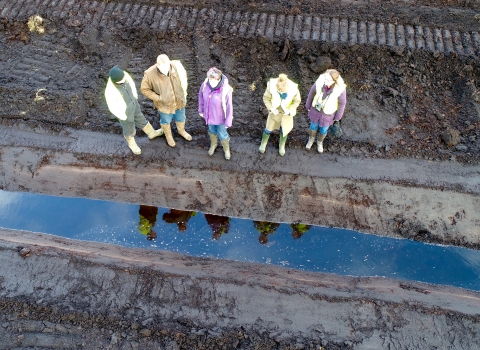Peat soils occupy around 3million hectares in the UK (12.2 % of total UK land area) and store large quantities of soil organic carbon. In a naturally functioning state, peatland ecosystems remove carbon dioxide (CO2) from the atmosphere and store it as peat under conditions of near-permanent waterlogging and oxygen deficiency.
Natural peatlands are also a major source for atmospheric methane (CH4). Overall, long-term net carbon accumulation exerts a net cooling effect on the global climate, helping to offset anthropogenic greenhouse gas (GHG) emissions and mitigating climate change.
UK peatlands are net contributors to UK GHG emissions due to the way they are managed. Overall, net GHG emissions from UK peatlands have been estimated at around 20 Mt CO2 year-1 (equivalent to approximately 4% of the UK’s total annual GHG emissions). Agricultural croplands and grasslands on lowland peat soils represent the largest net GHG source from UK peatlands, occupying around 15% of the total UK peatland area but contributing more than 50% of the total GHG emissions from UK peatlands. Mitigation of GHG emissions from these areas has therefore been identified as a major challenge to overcome if the UK is to achieve the target of net zero GHG emissions by 2050.
Lowland peatland regions including the East Anglian Fens, the Somerset Levels and the Humberhead Peatlands contain large areas of highly productive and valuable agricultural peat soils. The East Anglian Fens alone, for example, produce 22% of England’s total crop output, 33% of fresh vegetables, and supports a rural economy valued at £3.1 billion each year. However, the productivity and profitability of drainage-based peatland agriculture is achieved at the expense of large-scale GHG emissions, ongoing (and ultimate) loss of the underpinning peat resource and widespread land surface subsidence. Many lowland peatland areas are now below sea level at increased flood risk. Collectively, these issues have implications for the long-term viability of drainage-based peatland agriculture and rural economies in the East Anglian Fens and other peatland areas.
Wetland agriculture production systems represent one potential solution for mitigating the large GHG emissions and soil carbon losses associated with drainage-based peatland agriculture, whilst recognising the need to maintain agricultural output and rural livelihoods. Paludiculture cropping systems are widely used around the world, e.g., rice, but are yet to be trialled at lowland peatlands in the UK.
The potential for paludiculture systems to mitigate GHG emissions is informed by scientific evidence that shows a linear reduction in net CO2 emissions with decreasing drainage intensity, and so represents a land management with potential to drive systemic change in the way that lowland peatlands are managed. However, the economic viability and markets for candidate crops remain uncertain, and a lack of quantitative data limits scientific evaluation of the GHG mitigation potential of paludiculture compared to drainage-based peatland agriculture.
As part of the Water Works project (thanks to The People’s Postcode Lottery Dream Fund), the UKCEH are establishing and operating a new chamber-based system to continuously monitor CO2 and CH4 fluxes from the range of paludiculture crops being trialled, including commercially grown Sphagnum mosses. Flux measurements will be supported by a new research grade weather station, together with spatially distributed measurements of soil water content, soil temperature and field water levels. These new data will be used to:
-
Estimate the gaseous C balance (CO2 and CH4) of different paludiculture crops
-
Analyse and model the response of CO2 and CH4 fluxes to changing environmental conditions
-
Compare the C balance of paludiculture crops to that of conventional drainage-based agriculture. Based on the outcomes of the Water Works project, a longer-term vision will be to scale up the trials from plot to field scale for integrated carbon, water and energy flux monitoring using flux towers, and the modelling of future land use scenarios that include paludiculture systems.
The project builds on existing carbon flux monitoring work at the Great Fen: since April 2017, UKCEH has monitored CO2 and water fluxes using a flux tower (top image) at an area of ex-arable peatland which is currently undergoing rewetting and restoration to a conservation area. This flux tower forms part of the wider national UKCEH Land Flux Network of eddy covariance sites. The Water Works project compliments other UKCEH-led work on the carbon, water and greenhouse gas balance of lowland peatlands conducted under research projects funded by Natural England, Defra and BEIS.
References:
Committee on Climate Change (2018) www.theccc.org.uk/publication/net-zero-the-uks-contribution-to-stopping-global-warming/
Evans, Morrison et al (2016). http://sciencesearch.defra.gov.uk/Default.aspx?Menu=Menu&Module=More&Location=None&Completed=0&ProjectID=17584
Evans et al (2019) https://naei.beis.gov.uk/reports/reports?report_id=980
National Farmers Union (2019) www.nfuonline.com/pcs-pdfs/food-farming-in-the-fens_web/
Further information:
UKCEH Peatland factsheet www.ceh.ac.uk/sites/default/files/Peatland%20factsheet.pdf
Lowland Peatlands https://lowlandpeat.ceh.ac.uk/

